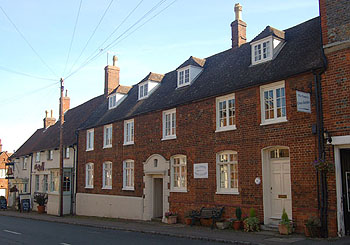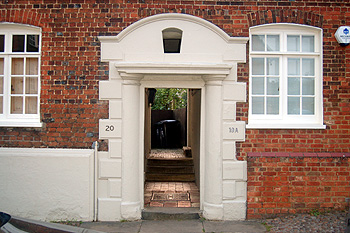19 and 20 Bedford Street Woburn

19 and 20 Bedford Street July 2007
19 and 20 Bedford Street was listed by the former Ministry of Works in October 1952 as Grade II, of special interest. It is built of red bricks with a steeply pitched 20th century tiled roof. It was built as the parish workhouse.
When the word workhouse is used people normally think of the large, grim 19th century institutions housing hundreds of people in ways not dissimilar to a prison. Such institutions were created by the Poor Amendment Act of 1834. Before this certain larger parishes had their own workhouses, these were, no doubt, grim but were usually not large. This, Woburn's first workhouse, was built a hundred years before the Poor Law Amendment Act, in 1734.
Bedfordshire & Luton Archives & Records Service has a small run of deeds, part of the Russell Estate collection which begin with an agreement dated 1st August 1734 [R6/63/18/1] in which churchwardens George Bosworth and Henry Clark and overseer of the poor, Henry Hatton agreed with Woburn bricklayer Thomas Edmonds to build a parish workhouse. Edmonds was to be paid £7/10/- per rod for all work under two feet from the ground, £100 when the first storey was complete and £100 when the roof was tiled. The Duke of Bedford had given 1,000 feet of timber to the project. The agreement specified that the workhouse should be built as set out below (note the original spellings).
"The length according as the ground will admit of where built upon and fifteen foot clear within wide and two story [sic] high each story to be seven foot clear within and containing Nine Rooms with Garretts in the Roof together with a Cellar of the Dimensions of Seventeen foot Long or thereabouts and Six foot clear of the Gurder and ceiled betwixt the Joyse, the Stairs in the Cellar to be curbed, the foundation up to the water table of the said Workhouse to be two Brick thick Excepting the party walls and a Brick and half thick up to the plate, the Gatehouse to be ceiled betwixt the Joyse as also all the other floors to be ceiled under the Joyse to be in every Room in the second story an Iron Casement and likewise in every Garrot one all, the upper floors to be floored with Red or Yellow seal one Inch thick without Sap and to hang a furnese and make an Oven in the Brewhouse belonging to the said Workhouse. The Scantleings of the Timber to be used in the said Workhouse or house of Maintenance to be of the bigness mentioned in the paper hereunto annexed" No paper, sadly, is now annexed to the agreement.
An agreement dated 1762 survives [X250/3] between Robert Carey, grocer and Stephen Preston, innholder, (churchwardens), George Bosworth, sadler and John Edmonds, plumber (overseers of the poor) and Thomas Dean of Leighton Buzzard, workhouseman. The parish officers would pay £140 per annum to the parish workhouse to provide for those with smallpox (unless they contract it while in Dean's care), to provide household goods such as. beds and bedding, copper, kettles for washing or brewing, barrels and tubs and to remove as soon as possible any who were not legal inhabitants of Woburn, bearing the legal costs involved and to provide clothing at their first coming into the workhouse. If children were admitted their parents were to accompany them.
In return Dean agreed to maintain the poor now on the overseers' books, on three days a week to give them butcher's meat (beef, mutton, pork, veal or lamb) and to keep them in as good clothes as when they arrived. He would also provide fuel and allow exit to those inhabitants who gave a week's notice to churchwardens or overseers. He would keep in condition the workhouse "household stuff" (casualty by fire excepted), lawfully govern the inhabitants, keep them to work, instruct them in reading English and the children in the church catechism, see they attended divine service on the Sabbath, see they take care they behaved themselves and would not admit anyone not belonging to Woburn.
The Parish registers for Woburn show that on 28th April 1765 Mary, wife of Thomas Dean, was buried. The agreement was renewed two months later. By this date, however, the sum paid had risen to £200 per annum. All parties bound themselves to the tune of £400 apiece. The agreement was once more renewed in 1768, again at £200 per annum. Then disaster struck.
In January 1769 The Northampton Mercury had the following notice: "WHEREAS THOMAS DEAN, Master, or Governor, of the Work-House for Maintenance of the Poor of the said Parish of Woburn, hath some time since absented himself from the said House, and from the Care of the Poor of the said Parish, contrary to his Contract with the Officers of the said Parish; This is therefore to give Notice to the said THOMAS DEAN, that unless he returns to the said House, and Care of the said Poor, within fourteen Days from the Date hereof, the Officers of the said Parish will put the Bond in force which lies against the said THOMAS DEAN, and also sell or dispose of by public sale the Effects he has left in the said House. JOHN ADAMS, HENRY CLARKE, Overseers of the Poor".
History leaves no word as to what happened to Thomas Dean. Presumably he either returned or someone filled his place. On the next three year renewal of the agreement on 6th May 1771 the agreement was made with James Gilbert, the sum now being £220 per annum, with the churchwardens and overseers agreeing to pay an extra twenty five shillings for mops, broom, dishes, spoons, ladles, chamber pots, platters, spindles "and all such small utensils".
A stray return of the inhabitants of the workhouse made in 1816 survives [R4/608/35], the names being as follows:
- Mrs. Goodey [who may be the Mistress, since her name is at the head of the list and not indented like the others, or given an age];
- William Shaw aged 78;
- John Goodman aged 60;
- Ann Odell aged 73;
- Mrs. Bunkling aged 80;
- June Frazier aged about 40;
- Mary Morley aged about 40;
- Esther Shovel aged 15;
- Ann Pilkington aged 6;
- John Pilkington aged 7;
- William Shovel aged 13;
- Samuel Shovel aged 8;
- George Brewer aged 12;
- William Brewer aged 10;
- Ann Ward & child no age given;
- Henry Grover[?] aged 10.
In 1833 a notorious Bedfordshire poacher, James Clare was committed to prison. He had been imprisoned thirty one times for poaching but on this occasion his offence was "ill-treating the mistress of Woburn Workhouse", perhaps the same Mrs. Goodey as listed in 1816. On 1st December that year he died in prison, aged 82 [QGR5/53], an entry of 29th November 1833 [QGR5/52] describing him as “in a dying state and appears quite insensible”.
When the Poor Law Union workhouse was built there was no longer a need for the parish workhouse. The Poor Law Commissioners gave their consent to sell the building in 1837, the minister, churchwardens and overseers likewise agreeing the same year [R6/63/18/2]. On 6th January 1838 the Guardians of the Poor in the Woburn Union sold the workhouse, together with two cottages on Bedford Street erected twenty years before in place of the pest house (further along Bedford and on the left hand side), to the Duke of Bedford for £757.
The Rating and Valuation Act 1925 specified that every building and piece of land in the country was to be assessed to determine its rateable value. Woburn, like much of the county was valued in 1927 and the valuer visiting 19 and 20 Bedford Street [DV1/C137/93-94] found that, like most of Woburn, the two premises were still owned by the Duke of Bedford’s London and Devon Estates Company.
Number 19 was occupied by F. Harwood whose rent was “in wages”, he obviously worked for the duke. His accommodation comprised a reception room, two living rooms, a nursery and a kitchen downstairs with two bedrooms and two attics above. There was a cellar beneath. A “good” barn and W. C. stood outside.
Number 20 was in the occupation of Cyril Herbert, a cabinet maker. His rent was £16 per annum for an office, a living room and a kitchen on the ground floor, with a cellar beneath, three bedrooms on the first floor with four attics (“poor”) above. A coachhouse, a barn and W. C. stood outside along with a workshop measuring 20 feet by 13 feet 6 inches. Directories for Bedfordshire were published every few years from the early 19th to mid 20th centuries and Cyril Herbert is listed in the directories of 1910, 1914, 1920, 1924, 1928 and 1931.
The valuer commented: “This was part of old Clubhouse? Pub probably, lot was waste space” he clearly did not know about the parish workhouse but as this was nearly a century earlier it is not really surprising!

The entrance to the former workhouse May 2012